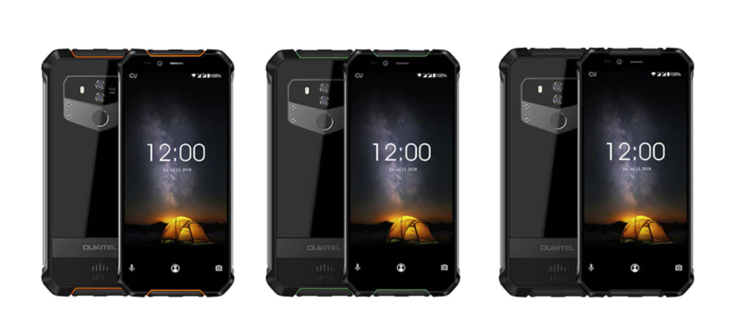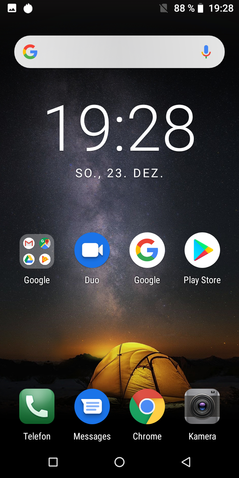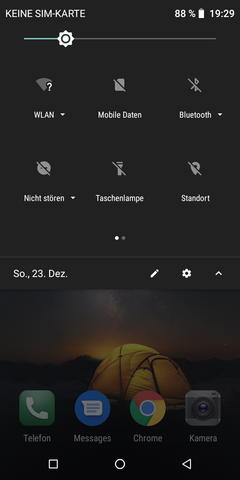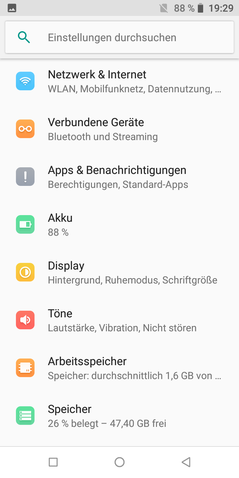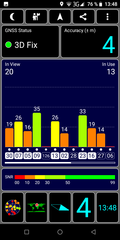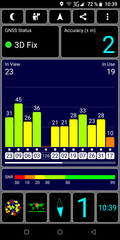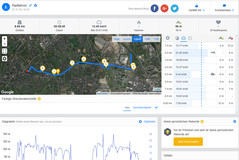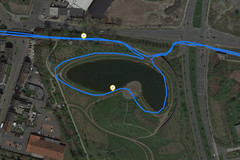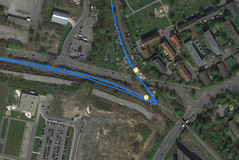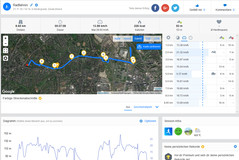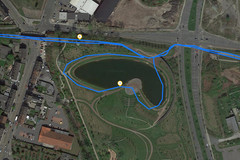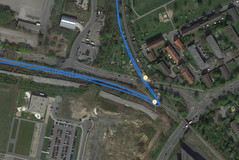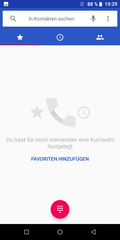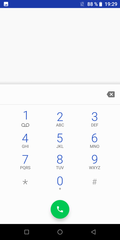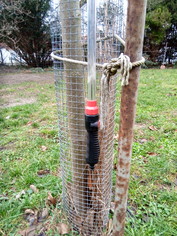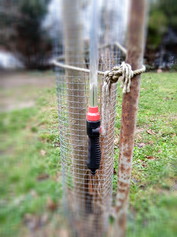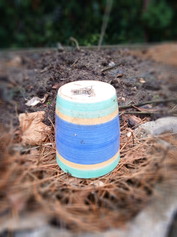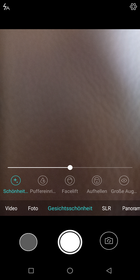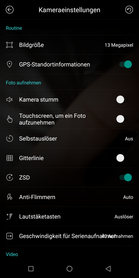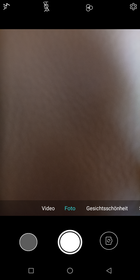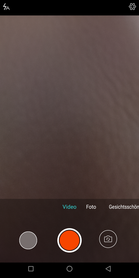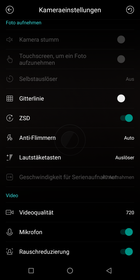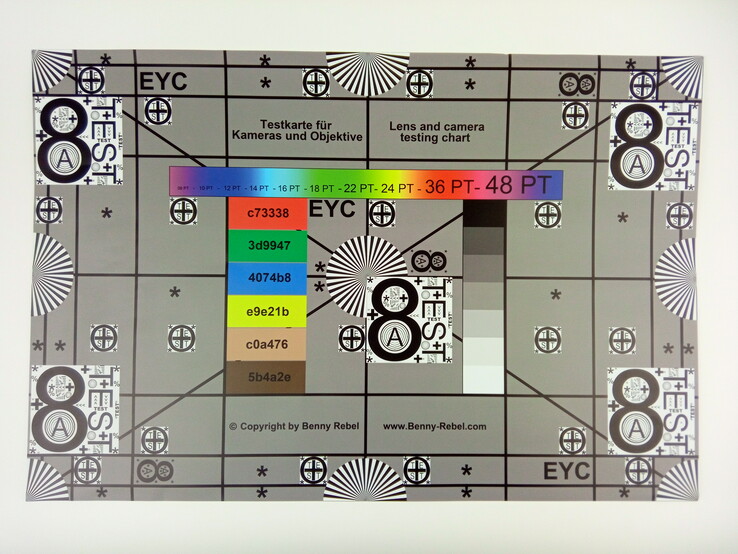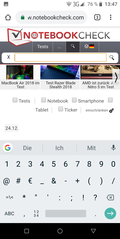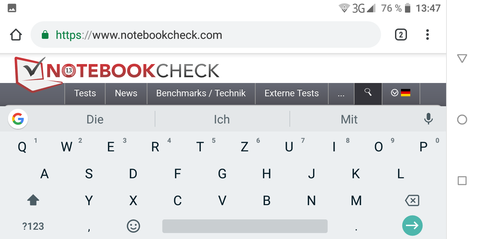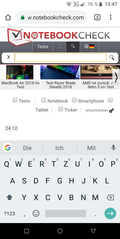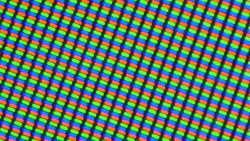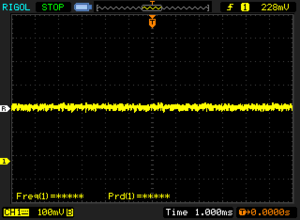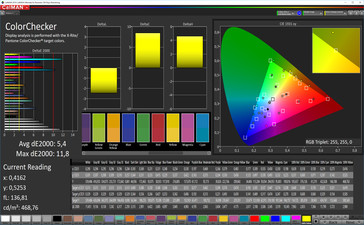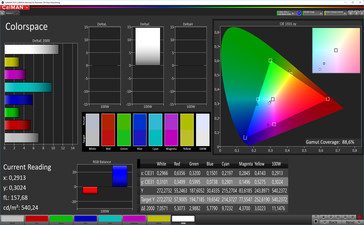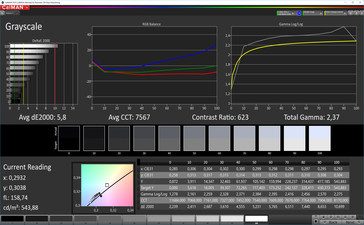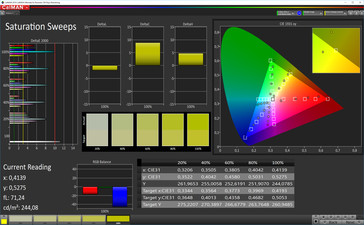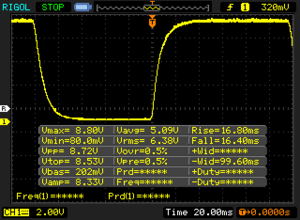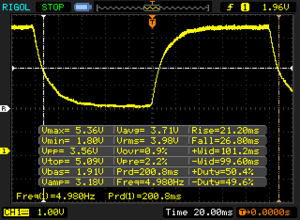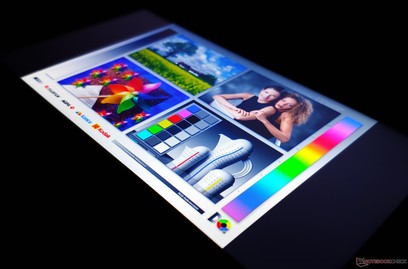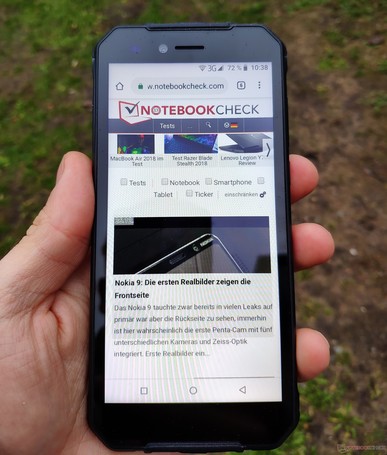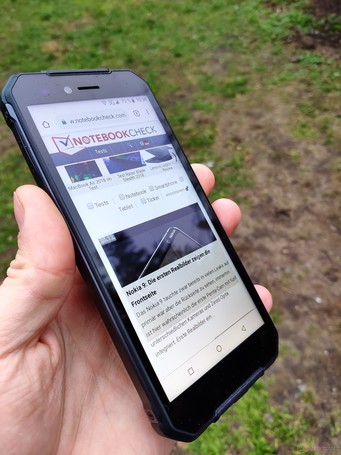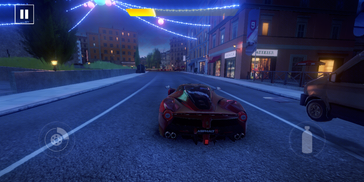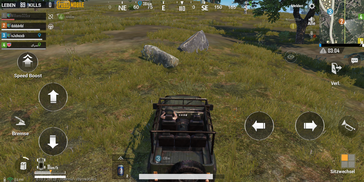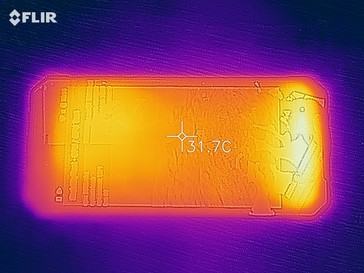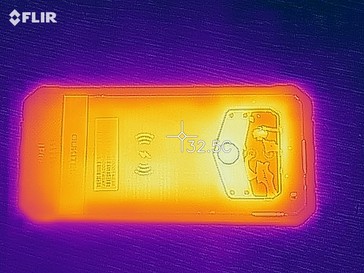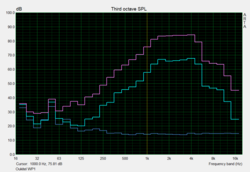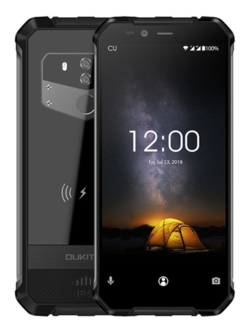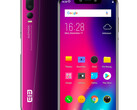Oukitel WP1 Smartphone Review
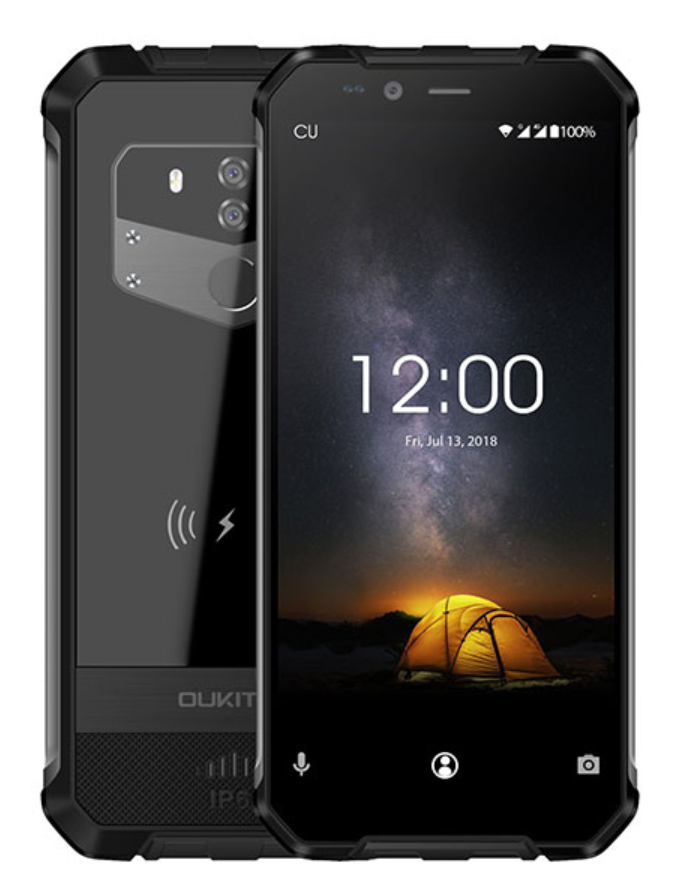
The WP product line from the Shenzhen-based manufacturer consists of mid-range smartphones that are especially good in the great outdoors. This is why the Oukitel WP1 offers a massive, drop-proof case, which has an IP68-certification, meaning that it is both water- and dust-resistant.
The smartphone is powered by an octa-core SoC from MediaTek and has 4 GB of RAM. There is a 13+2 MP dual-camera system on the back of the smartphone. The built-in IPS panel has an HD resolution and measures 5.45 inches diagonally. It features a 2:1 aspect ratio.
The current street price of the Oukitel WP1 is around 150 Euros ($171) and the smartphone can be purchased from importers - you can learn everything you need to know about importing a smartphone from Asia in our buying guide that is specifically dedicated to this topic. With such a price tag, the Oukitel WP1 lands itself squarely in the highly competitive entry-level price range. The competing devices that we chose for comparison purposes include: The Poptel P9000 Max, the Blackview P10000 Pro and the Ulefone Armor X, as well as Oukitel’s own WP2. The less-robust smartphones from the same sub-200 Euro ($228) price range are the Xiaomi Redmi 6 Pro and the BQ Aquaris U2.
Case - Oukitel WP1 with an IP-certification
The front of the Oukitel WP1 consists of scratch-resistant glass and the back is made of plastic and metal. The great rigidity of the smartphone can be attributed to the thick plastic sides, which also give the Oukitel WP1 its mighty weight of 256 grams. As usual with rugged smartphones, the Oukitel WP1 does not feel great in the hand, thanks to its thickness of 15 millimeters and its robust build. However, the Chinese smartphone impresses with its IP68-certification, which guarantees that the smartphone can survive for a while under 1.5 meters of fresh water.
The 5.45-inch screen of the mid-range smartphone has very thick bezels. The screen-to-body ratio only amounts to 65%. However, the competition in this specific niche of the smartphone market does not offer devices with much thinner bezels.
The non-removable plastic back cover exhibits a little flex. Nevertheless, the quality of the case is still quite satisfactory. The volume buttons and the power button are located on the right side of the device. They sit tightly in their cutouts and have a clear actuation point.
Connectivity - Oukitel smartphone with wireless charging & reverse charging
The Oukitel smartphone has 64 GB of internal eMMC storage. However, only 52 GB of storage space is available straight out of the box. The amount of storage space can be expanded with the help of a microSD card. That being said, users who choose to do so will only be able to use one SIM card. The integrated microSD card reader supports the current standards such as SDHC and SDXC and allows external storage devices to be utilized as internal storage. Our reference-grade SD card Toshiba Exceria Pro M501 is recognized by the Oukitel WP1, but its exFAT file system is not, because it is not supported by the smartphone.
Wi-Fi direct and Miracast can be used to wirelessly cast your screen content to an external display. Thanks to an OTG adapter, peripheral devices such as keyboards and flash drives can be connected to the smartphone via its microUSB port, which supports only USB 2.0 speeds. Other major features for the lovers of the great outdoors include a huge 5000-mAh battery with QuickCharge functionality, a compass and barometer, FM radio, wireless charging and reverse charging. The latter feature works similarly to the well-known charging feature of the Huawei Mate 20 Pro. However, in the case of the Oukitel smartphone, the charging is not done wirelessly but through a USB Type-C cable.
The Oukitel WP1 does not feature a 3.5-mm headphone jack, nor does it have an LED status indicator for notifications.
Software - Oukitel UI with little customization
The WP1 runs Android 8.1 with a custom launcher from Oukitel. The security patches of our review device are out of date. They were last updated in July 2018.
The user interface resembles stock Android. There were only a few changes made. The installed apps are not gathered together in the app drawer, but instead they are strewn across multiple home screens. No third-party apps have been preinstalled on the Oukitel smartphone.
Communication and GPS - Oukitel smartphone with accurate geolocation
The Oukitel WP1 supports Bluetooth 4.0. Unfortunately, it does not support NFC.
The integrated Wi-Fi module supports the IEEE-802.11 standards a, b, g and n and can operate not only in the 2.4 GHz spectral band but also in the 5 GHz band. In everyday use, the reception quality and the signal stability of the Wi-Fi module are quite good. In close proximity to the router (Telekom Speedport, W921V), we measured a signal attenuation of -48 dBm. In combination with our reference-grade router, the Linksys EA8500, the Oukitel WP1 achieves transfer rates of about 100 Mb/s, which is not unusual for a smartphone in this price range.
In the mobile Internet, the dual-SIM smartphone can achieve a download speed of up to 300 Mb/s, thanks to its LTE Cat-6 module. Both SIM cards can operate in 4G networks. However, the built-in LTE module only supports five LTE bands. Fortunately, all the LTE bands that are relevant in Germany are supported, including LTE band 20.
For geolocation, the Oukitel smartphone relies on the main global-positioning systems: GPS, GLONASS as well as SBAS. Both outdoors and indoors, your location is acquired relatively quickly and with a margin of error of about two to four meters.
In order to determine how accurate our review device is when it comes to geolocation, we take it with us on a bike ride. During this ride, we are also accompanied by the professional navigator Garmin Edge 500. Here we use both the smartphone and the navigator to map the same route in parallel. The rugged smartphone does not deviate too much from the professional navigator. There is only a 10-meter difference between the mid-range smartphone and the Garmin Edge 500 in our 8.5-km route.
Telephony and Call Quality - Oukitel WP1 with Wi-Fi calling
The call quality of the Oukitel WP1 is on a good level. We did not encounter any issues while making phone calls. Our call partner described the quality of the microphone as good - voices are reproduced clearly. Unfortunately, this does not apply to the ear-speaker. Here, the voices sound distorted and very tinny. The smartphone supports Wi-Fi calling, but not VoLTE.
Cameras - Oukitel smartphone with a dual-camera setup?
The main 13MP (4160 x3120) camera on the back comes from Sony and features the image sensor known as the IMX135 CMOS. There is also an additional camera on the back from Samsung. Depth detection is the main advantage of a dual-camera system, because it enables users to create images with a Bokeh effect. However, this function does not work on the Oukitel WP1. Even if you cover up the second lens nothing will happen. This has no impact, because the Bokeh effect is software-generated.
These days, an aperture of f/2.8 can only be described as suboptimal. In low-light conditions, the 13 MP rear camera consistently delvers unusable images. Under good lighting conditions, the quality is good enough for occasional snapshots and social media. The Oukitel smartphone has trouble with focus and the dynamic range is quite poor. The photos also require some time to be taken.
The image quality of the front-facing camera is acceptable for a smartphone in this price range. The sharpness and color accuracy are quite good, as long as you disable all beauty effects. The Galaxycore GC 5025 image sensor manages to deliver photos with quite some noise even under normal lighting conditions. The front-facing camera can record 720p video at 30 FPS. The main camera can record video in 1080p at 30 FPS.
Accessories and Warranty - Oukitel WP1 with surprising extras
The box contains a modular charger (9.0 V, 2.0 A) with an appropriate USB cable, a SIM-card removal tool as well as a USB-C to 3.5-mm headphone jack adapter.
The Oukitel WP1 comes with a 12-month warranty. Please see our Guarantees, Return policies and Warranties article for country-specific information.
Input Devices and Handling - FaceUnlock and fingerprint scanner in the Oukitel WP1 are barely usable
The smartphone is controlled via on-screen buttons for “back”, “overview” and “home”. It does not support gesture controls. The capacitive 5-point multi-touch screen responds to inputs reliably. Straight out of the box, the Google Keyboard is used as the default virtual keyboard.
The active fingerprint sensor unlocks the Oukitel smartphone neither quickly nor reliably. After you put your finger on the fingerprint sensor, it takes quite a while for the smartphone to wake up from stand-by mode. The Oukitel WP1 can also be unlocked via face recognition. However, this function does not work in real life.
Display - Bright IPS Panel
The 5.45-inch LCD screen has an HD resolution (1440x720) and an 18:9 aspect ratio. This is why the pixel density falls below 300 PPI, which means that the screen content does not look especially sharp. However, this is good enough for day-to-day use and the screen-door effect does not become apparent until you hold the phone very close to your face.
The screen brightness of 580 cd/m² is actually quite high for a smartphone in this price range. However, the brightness is distributed very unevenly. With auto brightness enabled and the ambient light sensor engaged, we measured a similar brightness of 547 cd/m². We also got very similar results in our realistically oriented APL50 test, in which the screen displays a pattern that consists of evenly distributed dark and bright areas. Here we measured 544 cd/m².
| |||||||||||||||||||||||||
Brightness Distribution: 84 %
Center on Battery: 561 cd/m²
Contrast: 660:1 (Black: 0.85 cd/m²)
ΔE ColorChecker Calman: 5.4 | ∀{0.5-29.43 Ø4.78}
ΔE Greyscale Calman: 5.8 | ∀{0.09-98 Ø5}
88.6% sRGB (Calman 2D)
Gamma: 2.37
CCT: 7567 K
| Oukitel WP1 IPS, 1440x720, 5.5" | Oukitel WP2 IPS, 2160x1080, 6" | Ulefone Armor X IPS, 1440x720, 5.5" | Blackview P10000 Pro IPS, 2160x1080, 6" | Poptel P9000 Max LCD IPS, 1920x1080, 5.5" | Xiaomi Redmi 6 Pro LCD IPS, 2280x1080, 5.8" | BQ Aquaris U2 LCD IPS, 1280x720, 5.2" | Xiaomi Mi Mix 3 OLED, 2340x1080, 6.4" | |
|---|---|---|---|---|---|---|---|---|
| Screen | -1% | 29% | -2% | -2% | 15% | 14% | 41% | |
| Brightness middle (cd/m²) | 561 | 472 -16% | 564 1% | 513 -9% | 406 -28% | 554 -1% | 392 -30% | 599 7% |
| Brightness (cd/m²) | 537 | 456 -15% | 541 1% | 507 -6% | 397 -26% | 538 0% | 390 -27% | 593 10% |
| Brightness Distribution (%) | 84 | 86 2% | 91 8% | 89 6% | 90 7% | 91 8% | 84 0% | 96 14% |
| Black Level * (cd/m²) | 0.85 | 0.32 62% | 0.37 56% | 0.37 56% | 0.38 55% | 0.61 28% | 0.37 56% | |
| Contrast (:1) | 660 | 1475 123% | 1524 131% | 1386 110% | 1068 62% | 908 38% | 1059 60% | |
| Colorchecker dE 2000 * | 5.4 | 9.1 -69% | 5.1 6% | 8.5 -57% | 6.7 -24% | 4.86 10% | 4.88 10% | 1.4 74% |
| Colorchecker dE 2000 max. * | 11.8 | 14.8 -25% | 9.6 19% | 15.2 -29% | 13.8 -17% | 8.46 28% | 10.23 13% | 3.2 73% |
| Greyscale dE 2000 * | 5.8 | 9.6 -66% | 5.4 7% | 10.6 -83% | 8.5 -47% | 5.3 9% | 3.9 33% | 2 66% |
| Gamma | 2.37 93% | 1.75 126% | 2.1 105% | 2.29 96% | 2.21 100% | 2.281 96% | 2.044 108% | 2.25 98% |
| CCT | 7567 86% | 8713 75% | 7755 84% | 10204 64% | 8858 73% | 7770 84% | 6819 95% | 6496 100% |
* ... smaller is better
Screen Flickering / PWM (Pulse-Width Modulation)
| Screen flickering / PWM not detected | |||
In comparison: 53 % of all tested devices do not use PWM to dim the display. If PWM was detected, an average of 8111 (minimum: 5 - maximum: 343500) Hz was measured. | |||
We measured a black value of 0.85 cd/m², which is pretty high for an IPS panel. The black value is similarly high in the APL50 test. Here it amounts to 0.86 cd/m². This is why the Oukitel WP1 has a rather low contrast ratio of 633:1.
In everyday use, the color reproduction of the IPS panel looks quite good to the naked eye. However, our measuring device that relies on SpectraCal's CalMAN software revealed a considerably elevated color temperature of 7567 K (the ideal value is 6500 K). Moreover, both the grayscale (5.8) and the mixed and primary colors (5.4) deviate significantly from the sRGB standard (here the ideal value is less than 3). Having said that, these are normal results for a smartphone with such a price tag.
Display Response Times
| ↔ Response Time Black to White | ||
|---|---|---|
| 33.2 ms ... rise ↗ and fall ↘ combined | ↗ 16.8 ms rise | |
| ↘ 16.4 ms fall | ||
| The screen shows slow response rates in our tests and will be unsatisfactory for gamers. In comparison, all tested devices range from 0.1 (minimum) to 240 (maximum) ms. » 89 % of all devices are better. This means that the measured response time is worse than the average of all tested devices (20.2 ms). | ||
| ↔ Response Time 50% Grey to 80% Grey | ||
| 48 ms ... rise ↗ and fall ↘ combined | ↗ 21.2 ms rise | |
| ↘ 26.8 ms fall | ||
| The screen shows slow response rates in our tests and will be unsatisfactory for gamers. In comparison, all tested devices range from 0.165 (minimum) to 636 (maximum) ms. » 82 % of all devices are better. This means that the measured response time is worse than the average of all tested devices (31.6 ms). | ||
The viewing angles of the IPS panel are quite wide. The screen content does not lose much brightness and the colors do not become distorted even at acute angles. However, colors do become slightly distorted at extremely acute angles.
Thanks to the high brightness, the Oukitel WP1 can be used outside without any problems. However, the low contrast ratio can prove annoying on sunny summer days.
Performance - MediaTek Helio P23 with good performance
The Oukitel WP1 relies on an octa-core chip from MediaTek. The Helio P23 MT6763V integrates eight ARM Cortex-A53 cores into two clusters: One cluster of high-performance cores and another cluster of energy-efficient cores. When compared to the Helio P23 MT6763T, the 2 GHz clock rate of the SoC found in the Oukitel WP1 is somewhat lower. The built-in graphics unit known as the ARM Mali-G71 MP2 features support for Vulkan and OpenGL ES 3.2.
In our benchmark suite, the Helio P23 in combination with 4 GB of RAM performs as well as the rest of the competition. Thanks to a low display resolution, both the CPU and the GPU benchmark results of the Oukitel WP1 are comparable to those of the Xiaomi Redmi 6 Pro, which features the Snapdragon 625. Other smartphones with the Helio P23 perform considerably worse than the Oukitel WP1.
In everyday use, the system performance of the Oukitel smartphone is satisfactory. By and large, there is no lag when you are navigating through the system menus. However, when you are multitasking the system becomes less responsive and the loading times grow longer.
| AnTuTu v6 - Total Score (sort by value) | |
| Oukitel WP1 | |
| Oukitel WP2 | |
| Ulefone Armor X | |
| Blackview P10000 Pro | |
| Xiaomi Redmi 6 Pro | |
| BQ Aquaris U2 | |
| Xiaomi Mi Mix 3 | |
| Average Mediatek Helio P23 MT6763V (62732 - 73075, n=4) | |
Surfing the web with the preinstalled Google Chrome Browser does not present any difficulties. The mid-range smartphone from Oukitel achieves decent results in all of our Internet benchmarks. When you are browsing the Internet with the Oukitel WP1, even demanding websites load relatively quickly and without any glitches.
| JetStream 1.1 - Total Score | |
| Xiaomi Mi Mix 3 (Chrome 70) | |
| Xiaomi Redmi 6 Pro (Chrome 68) | |
| Average Mediatek Helio P23 MT6763V (22 - 25.9, n=5) | |
| Oukitel WP1 (Chrome 70) | |
| Poptel P9000 Max (Chrome 68) | |
| Ulefone Armor X (Chrome 66) | |
| BQ Aquaris U2 (Chrome 67) | |
| Blackview P10000 Pro (Chrome 66) | |
| Oukitel WP2 (Chroome Mobile 70) | |
| Octane V2 - Total Score | |
| Average of class Smartphone (2228 - 121337, n=200, last 2 years) | |
| Xiaomi Mi Mix 3 (Chrome 70) | |
| Xiaomi Redmi 6 Pro (Chrome 68) | |
| Average Mediatek Helio P23 MT6763V (3998 - 4862, n=5) | |
| Oukitel WP1 (Chrome 70) | |
| Blackview P10000 Pro (Chrome 66) | |
| Poptel P9000 Max (Chrome 68) | |
| BQ Aquaris U2 (Chrome 67) | |
| Ulefone Armor X (Chrome 66) | |
| Oukitel WP2 (Chrome Mobile 70) | |
| Mozilla Kraken 1.1 - Total | |
| Ulefone Armor X (Chrome 66) | |
| Oukitel WP2 (Chrome Mobile 70) | |
| Oukitel WP2 (Chrome Mobile 70) | |
| Poptel P9000 Max (Chrome 68) | |
| BQ Aquaris U2 (Chrome 67) | |
| Blackview P10000 Pro (Chrome 66) | |
| Average Mediatek Helio P23 MT6763V (11309 - 13077, n=5) | |
| Oukitel WP1 (Chrome 70) | |
| Xiaomi Redmi 6 Pro (Chrome 68) | |
| Xiaomi Mi Mix 3 (Chrome 70) | |
| Average of class Smartphone (257 - 28190, n=155, last 2 years) | |
* ... smaller is better
The performance of the internal eMMC memory is similar to those of other mid-range devices. The performance of the integrated microSD card reader, which we benchmarked using our reference-grade SD card Toshiba Exceria Pro M501 (maximum read speed: 270 MB/s; maximum write speed: 150 MB/s), is also completely satisfactory.
| Oukitel WP1 | Oukitel WP2 | Ulefone Armor X | Blackview P10000 Pro | Poptel P9000 Max | Xiaomi Redmi 6 Pro | BQ Aquaris U2 | Xiaomi Mi Mix 3 | Average 64 GB eMMC Flash | Average of class Smartphone | |
|---|---|---|---|---|---|---|---|---|---|---|
| AndroBench 3-5 | -34% | -36% | -23% | -30% | 38% | -26% | 56% | 1% | 803% | |
| Sequential Read 256KB (MB/s) | 285 | 267.6 -6% | 255.3 -10% | 284.3 0% | 269.4 -5% | 278.7 -2% | 253.5 -11% | 675 137% | 277 ? -3% | 2223 ? 680% |
| Sequential Write 256KB (MB/s) | 241.3 | 98.6 -59% | 82.8 -66% | 112.3 -53% | 129.6 -46% | 212.9 -12% | 137.7 -43% | 206.8 -14% | 178.4 ? -26% | 1838 ? 662% |
| Random Read 4KB (MB/s) | 64.2 | 26.89 -58% | 14.7 -77% | 29.98 -53% | 35.1 -45% | 66.9 4% | 46.87 -27% | 133.2 107% | 60.7 ? -5% | 295 ? 360% |
| Random Write 4KB (MB/s) | 20.83 | 13.23 -36% | 10.17 -51% | 14.6 -30% | 11.23 -46% | 72.6 249% | 8.87 -57% | 19.54 -6% | 33.8 ? 62% | 335 ? 1508% |
| Sequential Read 256KB SDCard (MB/s) | 81.2 ? | 72.2 ? -11% | 81.5 ? 0% | 80.9 ? 0% | 72.9 ? -10% | 83.5 ? 3% | 79.4 ? -2% | 77.4 ? -5% | ||
| Sequential Write 256KB SDCard (MB/s) | 72.8 ? | 47.92 ? -34% | 62.6 ? -14% | 73.3 ? 1% | 53.2 ? -27% | 62.2 ? -15% | 61.6 ? -15% | 58.3 ? -20% |
Games - Surprisingly good gaming performance thanks to 720p resolution
The Oukitel Smartphone comes with the Mali-G71 MP2, which features two shader cores that are clocked at 770 MHz. The graphics unit supports the following APIs: Vulkan 1.0, OpenGL ES 3.1 and DirectX 11. Even demanding 3D titles from the Google Play Store such as PUBG Mobile can run smoothly on high settings on the Oukitel WP1. However, we recommend lowering the graphics settings to eliminate occasional stuttering. Asphalt 9 Legends runs perfectly smoothly on the highest settings.
Both the touchscreen and the motion sensor work very well while gaming.
Emissions - Oukitel smartphone with a tinny speaker
Temperature
The Oukitel WP1 does not get hot. However, the front of the smartphone does become quite warm. Under continuous load, the surface temperatures at the front of the device reach over 38 °C (100.4 °F).
(+) The maximum temperature on the upper side is 38.7 °C / 102 F, compared to the average of 35.2 °C / 95 F, ranging from 21.9 to 247 °C for the class Smartphone.
(+) The bottom heats up to a maximum of 32.2 °C / 90 F, compared to the average of 34 °C / 93 F
(+) In idle usage, the average temperature for the upper side is 30.9 °C / 88 F, compared to the device average of 32.9 °C / 91 F.
Speakers
The mono-speaker on the back has a very high volume of almost 93 dB(A). As usual with smartphones in this price range, the mids and the highs are a little overrepresented. However, as you can see from the sound graph below, there is almost no bass present. The mids and the highs are also far from being linear.
At high volume, the sound becomes distorted and very tinny. If you are going to use the WP1 to listen to music, then we recommend that you connect a pair of headphones to the device via the USB Type-C port. You can also connect external speakers to the Oukitel smartphone via Bluetooth. Doing this will result in a much better sound quality.
Oukitel WP1 audio analysis
(+) | speakers can play relatively loud (92.9 dB)
Bass 100 - 315 Hz
(-) | nearly no bass - on average 22.6% lower than median
(±) | linearity of bass is average (8.2% delta to prev. frequency)
Mids 400 - 2000 Hz
(±) | higher mids - on average 9.5% higher than median
(±) | linearity of mids is average (7.2% delta to prev. frequency)
Highs 2 - 16 kHz
(±) | higher highs - on average 10.3% higher than median
(+) | highs are linear (6% delta to prev. frequency)
Overall 100 - 16.000 Hz
(±) | linearity of overall sound is average (28.2% difference to median)
Compared to same class
» 73% of all tested devices in this class were better, 5% similar, 22% worse
» The best had a delta of 11%, average was 35%, worst was 134%
Compared to all devices tested
» 85% of all tested devices were better, 3% similar, 12% worse
» The best had a delta of 4%, average was 24%, worst was 134%
Poptel P9000 Max audio analysis
(+) | speakers can play relatively loud (85.5 dB)
Bass 100 - 315 Hz
(-) | nearly no bass - on average 41.3% lower than median
(±) | linearity of bass is average (8.9% delta to prev. frequency)
Mids 400 - 2000 Hz
(±) | reduced mids - on average 6.3% lower than median
(±) | linearity of mids is average (9.1% delta to prev. frequency)
Highs 2 - 16 kHz
(±) | higher highs - on average 5.4% higher than median
(+) | highs are linear (5.4% delta to prev. frequency)
Overall 100 - 16.000 Hz
(±) | linearity of overall sound is average (29.4% difference to median)
Compared to same class
» 76% of all tested devices in this class were better, 4% similar, 20% worse
» The best had a delta of 11%, average was 35%, worst was 134%
Compared to all devices tested
» 87% of all tested devices were better, 3% similar, 10% worse
» The best had a delta of 4%, average was 24%, worst was 134%
Battery Life - Oukitel WP1 lasts for a long time
Energy Consumption
The Oukitel WP1 beats the rest of the competition in terms of energy consumption. The smartphone draws a moderate amount of power both when it is under load and when it is idle.
| Off / Standby | |
| Idle | |
| Load |
|
Key:
min: | |
| Oukitel WP1 5000 mAh | Oukitel WP2 10214 mAh | Ulefone Armor X 5500 mAh | Blackview P10000 Pro 11000 mAh | Poptel P9000 Max 9000 mAh | Xiaomi Redmi 6 Pro 4000 mAh | BQ Aquaris U2 3100 mAh | Xiaomi Mi Mix 3 3200 mAh | Average Mediatek Helio P23 MT6763V | Average of class Smartphone | |
|---|---|---|---|---|---|---|---|---|---|---|
| Power Consumption | -14% | -22% | -5% | 6% | -41% | 6% | 15% | -5% | -36% | |
| Idle Minimum * (Watt) | 0.77 | 1.14 -48% | 1.22 -58% | 0.63 18% | 0.92 -19% | 1.3 -69% | 0.8 -4% | 0.49 36% | 0.851 ? -11% | 0.848 ? -10% |
| Idle Average * (Watt) | 1.98 | 1.99 -1% | 2.07 -5% | 2.2 -11% | 1.9 4% | 2.1 -6% | 1.4 29% | 0.67 66% | 2.01 ? -2% | 1.435 ? 28% |
| Idle Maximum * (Watt) | 1.99 | 2.03 -2% | 2.14 -8% | 2.3 -16% | 2.19 -10% | 3.7 -86% | 1.9 5% | 0.87 56% | 2.26 ? -14% | 1.62 ? 19% |
| Load Average * (Watt) | 3.89 | 3.72 4% | 4.92 -26% | 3.57 8% | 3.1 20% | 4.5 -16% | 3.4 13% | 3.64 6% | 3.74 ? 4% | 7 ? -80% |
| Load Maximum * (Watt) | 4.78 | 5.96 -25% | 5.4 -13% | 5.82 -22% | 3.12 35% | 6 -26% | 5.3 -11% | 9.04 -89% | 4.9 ? -3% | 11.3 ? -136% |
* ... smaller is better
Battery Life
In our Wi-Fi test, in which we set the brightness to 150 cd/m², the 5000-mAh battery lasts for about 16 hours. Not a bad result, considering the fact that Oukitel’s own WP2 lasts only about 20% longer, despite having double the battery capacity.
| Oukitel WP1 5000 mAh | Oukitel WP2 10214 mAh | Ulefone Armor X 5500 mAh | Blackview P10000 Pro 11000 mAh | Poptel P9000 Max 9000 mAh | Xiaomi Redmi 6 Pro 4000 mAh | BQ Aquaris U2 3100 mAh | Xiaomi Mi Mix 3 3200 mAh | |
|---|---|---|---|---|---|---|---|---|
| Battery runtime | ||||||||
| WiFi v1.3 (h) | 16.2 | 19.1 18% | 14.1 -13% | 35.8 121% | 22.4 38% | 14.5 -10% | 11.4 -30% | 12 -26% |
Pros
Cons
Verdict - Niche smartphone with the right to exist
In the course of our review, the Oukitel WP1 revealed quite a few flaws such as the low contrast ratio of the IPS panel, the outdated security patches, the tinny speaker and the secondary rear camera that does not work. Nevertheless, the Chinese smartphone represents a well-rounded package for those who like to spend time outdoors. It impresses with its low price and good hardware. Moreover, the Oukitel WP1 also does well in the areas that are essential for a rugged smartphone.
The Oukitel WP1 has the right to exist in the realm of rugged smartphones. Those who do not need a robust case will be better off getting a smartphone that is easier to hold and offers more power in the same 150-Euro ($171) price range.
Those who can live with the HD resolution of the Oukitel WP1 will get a smartphone that offers good performance and can run even demanding games, thanks to its low pixel density.
Oukitel WP1
- 01/02/2019 v6 (old)
Marcus Herbrich




